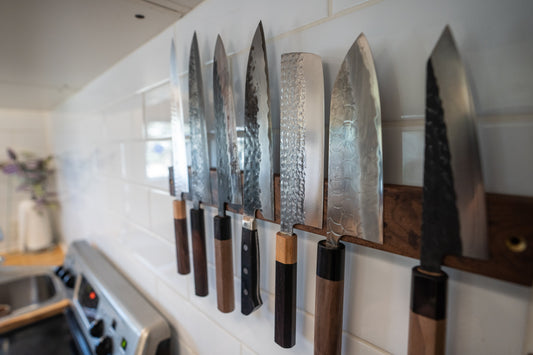
Dento Kogeishi: the Highest Honour for Japanese Craftspeople
Takumi Ikeda, the new head of Anryu Hamono and Dento Kogeishi.
All photos by Visti Kjar, Down North Photography.
Japan has a lot of traditional crafts that have been passed down for generations. Each region has their own unique crafts, such as bladesmithing, kimono making, urushi lacquering, etc. Since the industrialization and modernization of Japan, the number of folks practicing these traditional skills has been in decline. From 288,000 people in the traditional crafts industry in 1979, there are now only about 63,000. Around 50 years ago, the government of Japan realized the need to protect and promote these traditional crafts and created a certification of sorts called “Dento Kogeishi,” or certified traditional craftsperson in 1974.
To become a Dento Kogeishi, a person has to work in their industry for at least 12 years and take extensive exams for both knowledge and technical skills. In reality, they have to work much longer than 12 years to be certified, as most artisans work under an apprenticeship first so that they can gain the approval of their mentors. Those who complete the certification process are expected to preserve, protect, promote and hopefully pass down the tradition. The actual skill exam is done region by region, so each area has a committee or association that runs the exams. This ensures that each regional committee can guarantee the skills and knowledge of the Dento Kogeishi specific to their area. This makes the title Dento Kogeishi an absolute assurance of skill and expertise within the traditional crafts industry.
 Tsukasa Hinoura, one of the best-known Dento Kogeishi among knife nerds.
Tsukasa Hinoura, one of the best-known Dento Kogeishi among knife nerds.
While this system helps preserve traditional arts, it also has a lot of limitations. For knife making, there are only six regions (Echizen, Sakai, Shishu, Sanjo, Banshu-Miki, Tosa) where artisans can attain this Dento Kogeishi title. This is because the purpose of the government is to preserve and promote the regional traditional craft industries rather than each specific traditional craft. So there is no such thing as Dento Kogeishi for blacksmithing or kitchen knife making; instead, they would be a Dento Kogeishi for Echizen Uchi hamono (Echizen smithed blades). So, highly skilled blacksmiths like Moritaka-san or Takeda-san, who come from long-standing traditions but live outside certain regions, will never be certified as Dento Kogeishi.
Additionally, the craftspeople have to be a member of the association that performs the examination. Masashi Yamamoto-san, for example, works in the Sanjo area but does not belong to any of those blacksmith associations. Therefore he has no plan to become a Dento Kogeishi despite his skill and experience. Many craftspeople also aren’t interested in getting much attention and prefer to keep things low-key, such as Morihiro-san in Sakai. He is considered one of the best knife sharpeners in Sakai despite not being certified as Dento Kogeishi.
 As many younger blacksmiths step up, many Dento Kogeishi of the previous generation, such as Takeshi Saji, step back from the forge and focus on training future artisans and steering their companies towards a successful future.
As many younger blacksmiths step up, many Dento Kogeishi of the previous generation, such as Takeshi Saji, step back from the forge and focus on training future artisans and steering their companies towards a successful future.
Regardless of these limitations, the credential of Dento Kogeishi is a massive honour to earn and guarantees the quality of the work coming from those who are certified. We are thrilled and fortunate to represent so many blacksmiths and knife makers who are Dento Kogeishi. These are the Dento Kogeishi whose work we have stocked or currently stock at Knifewear:
Echizen: Takeshi Saji, Katsushige Anryu (retired), Hideo Kitaoka, Hiroshi Kato (retired), Katsuyasu Kamo, Nao Yamamoto, Yu Kurosaki, Makoto Kurosaki, Takumi Ikeda, Kazuo Nomura (Works with Saji-san).
Sanjo: Tsukasa Hinoura, Ryoichi Mizuochi, Chuichiro Sone, Isao Mizuno, Tokifusa Iizuka, Masayuki Iizuka.
Sakai: Hirotsugu Tosa, Kenji Togashi, Tomoyuki Ajioka (sharpener), Mitsuo Yamatsuka (sharpener), Yoshikazu Tanaka, Shogo Yamatsuka
If you'd like to learn more about these folks and see many of them in action, check out the two documentaries we made about Japanese knife-makers:





